Klondike Solitaire Rules
Anna | Updated October 29, 2024
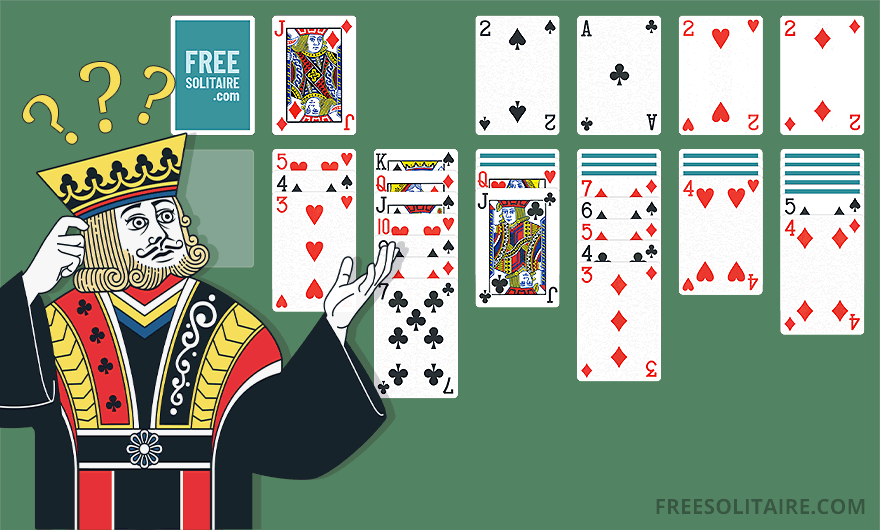
If you grew up with a computer or a parent or grandparent who enjoyed playing cards, chances are you've played Klondike Solitaire before and already know the basics.
However, that is not everyone! If you are just beginning your Solitaire journey—Welcome! Perhaps you would be interested in a comprehensive explanation of how to play our free Solitaire games? You've got it. In this article, we'll explain exactly how to play the Klondike games on our website. We will try to make it as simple as possible, using illustrations along the way so you can see exactly what we mean.
Alright, let's start with the key terms. In each game, certain words are used within the context of that game. Perhaps you know how to play Solitaire itself but don't yet know these terms—We can help! In the image below, we highlight and explain the terms used in Klondike Solitaire.

- Tableau: Solitaire is played on the tableau with a complete deck of 52 playing cards, 28 divided into seven columns. The first column has one card placed, while and each subsequent column adds one more each time. All cards are closed except the top card of each column.
- The Stockpile: 24 cards have not been dealt on the tableau at the beginning of the game. These cards form the stockpile.
- The Talon or "Waste" Pile: The cards from the stockpile are dealt one by one here.
- Foundation: The tableau cards are stacked on the foundation or ace stacks. This idea is explained in greater detail below.
Drawing Cards (One-Card Draw)
Solitaire comes with options! Before starting the game, most games present you with a menu to choose whether you prefer to draw one or three cards. These instructions are about drawing one card because this is easiest for novice players.
The Objective of the Game
The goal of Solitaire is to move all playing cards from the tableau and stockpile to the four foundations. It should be done in order from low to high, starting with the four Aces. For example, at the bottom of each pile in the final situation is an Ace, followed by a 2, 3, 4, etc. On top of each pile is the King. The four stacks correspond to the four colors of the deck; therefore, each foundation contains only one color of cards.
Beginning the Game
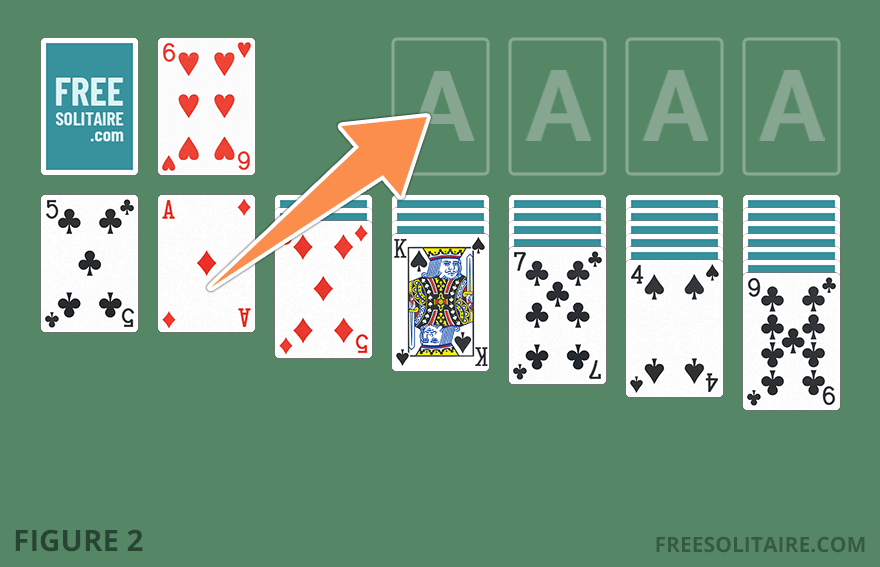
When the game begins, you begin by focusing on the tableau to assess your moves. Knowing that the game's objective is to move the cards to the foundation, you must do so in the correct order, starting with the Aces. First, look to see if there are any Aces open on the tableau that can be moved to the foundation. This is the case in Figure 2. That's an excellent start already. Not only does this put the first card on the foundation, but it also reveals a new card under the Ace (a red 7, see figure 3).
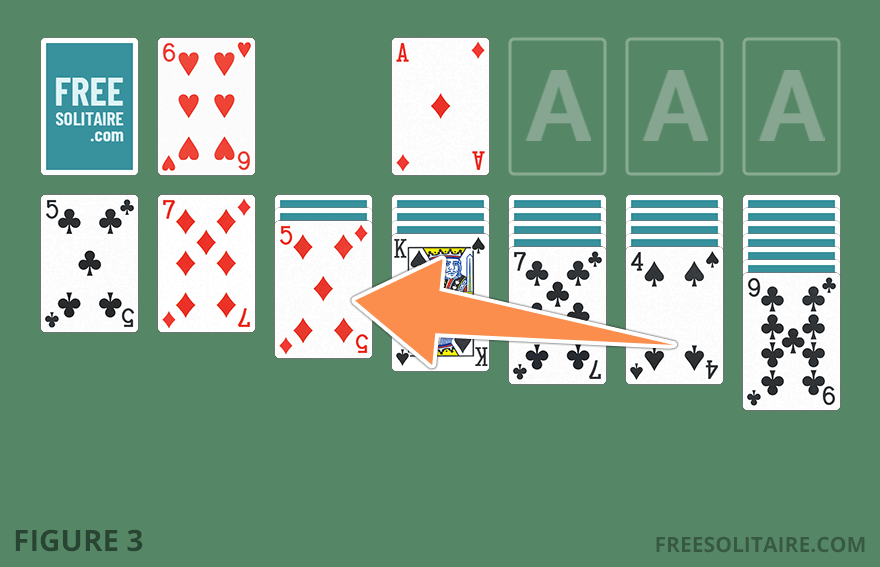
After any open Aces have been found and moved, you will attempt to put the cards in order as much as possible. On the tableau, you should make piles, placing each card atop a card with a value one higher than the card itself. Moreover, this can only be done in alternating colors, meaning that red cards can only be placed on black cards and vice versa. This can be seen in Figure 3, where there is a black 4 in column six. You would drag this to the red 5 in column three, revealing the card under the black 4. Continue to lay cards on top of each other in this manner until there are no more options on the tableau.
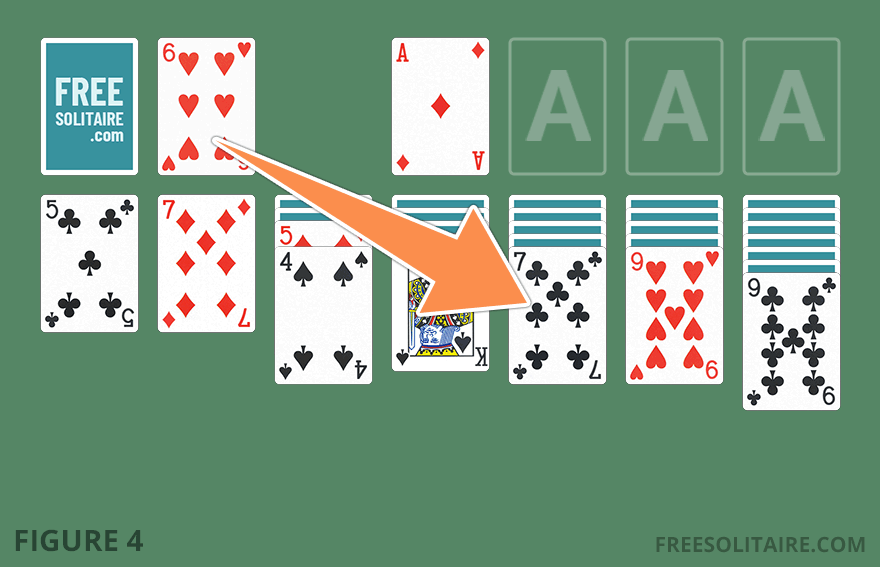
Next, we look at the stockpile. There are usually cards you can use to make piles on the tableau or place directly on the foundation. You can only view the cards on the stockpile one at a time (or in threes if you choose that option at the start of the game) by clicking on them—or by flipping them over if you're not playing digital Solitaire. For example, the stockpile in Figure 4 contains a red 6. We place this card on top of the black 7 in column five, which suddenly makes the black 5 from column one fit on that same pile. Below the black 5, we do not unlock a new card, but an empty space is created. Only a King may be placed on this space. You should preferably remove these from the tableau to unlock new cards. If there is no King available on the tableau, look for it in the stockpile.
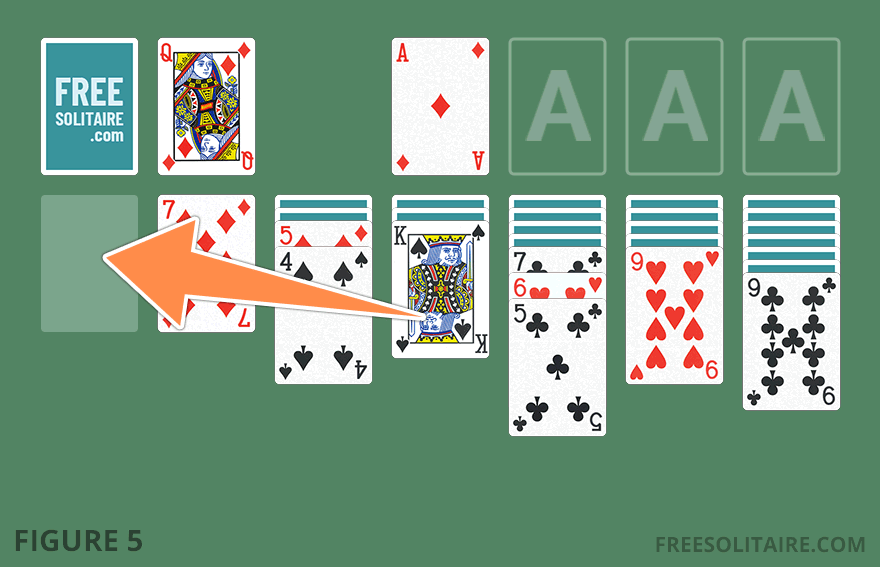
In Figure 5, we place the King from column four into the vacant spot in column one. After this placement, you will try to place as many cards as possible on that pile in the correct order, looking first in the tableau and then in the stock or discard pile for suitable cards. The more stacks there are in order on the tableau, the easier it is to move the cards to the foundation later. You can also move several cards at once, but it can only be done with stacks of consecutive cards.
Scoring
- You get five points for a card you move from the discard pile to the tableau.
- Moving a card from the discard pile or tableau to the foundation gets you ten points.
- Turning over a covered card scores five points.
- When you move a card from the tableau to the foundation and immediately unlock a covered card, you earn fifteen points with one move.
In addition, a time bonus score is calculated based on your playing time. The bonus is based on a formula where the number 700,000 is divided by the number of seconds it takes you to complete the game, resulting in a score added to the number of points you scored with cards. If you complete the game within 30 seconds, you will not receive any bonus points.
Solitaire with Three-Card Draw
The rules above apply to both the game version where you move one card from the stockpile to the discard pile and to the version where you draw cards from the stockpile in sets of three. The three-card draw version is more difficult because not all cards from the stockpile are immediately available for use. Invariably, only the top card of the three is available. If you can move that card to the tableau or the foundation, then the card below it becomes available.
Strategy
While luck certainly plays a role in Solitaire, strategy is also essential. In this guide, we explain some Solitaire strategies.
